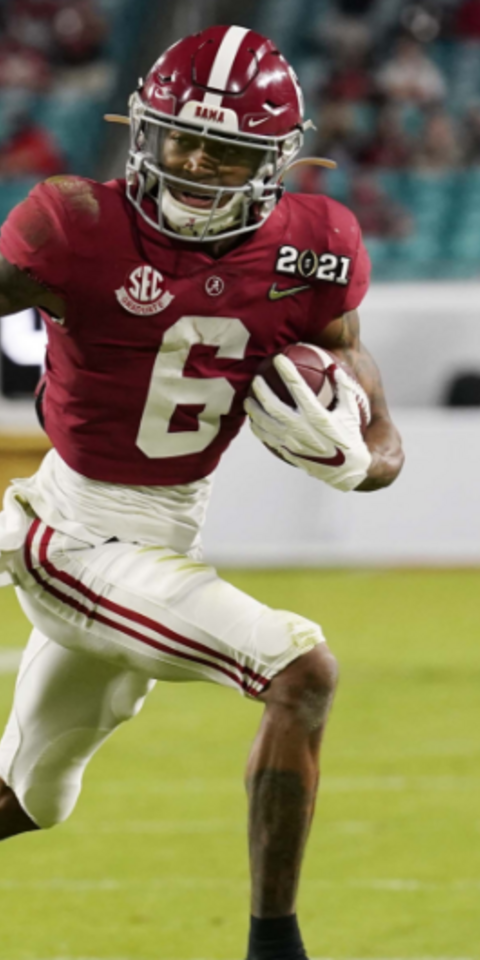John Heisman played football for two different Ivy League schools, one of them while attending law school, and played at guard, tackle and center, so he was pretty much like the guys contending for the Heisman trophy these days.
The Heisman trophy itself, the “embodiment of a muscular footballer driving for yardage,” is modeled on Ed Smith, who was one of the top players for NYU in 1934, back when that school had a football team, which is why it looks like a wide receiver in action, not an interior lineman.
DeVonta Smith wasn’t the first wide receiver to win the Heisman, that was Tim Brown of Notre Dame in 1987, followed just four years later by Michigan’s Desmond Howard, who became known for striking the “Heisman pose” after scoring a touchdown. (The winner in 1997, Charles Woodson of Michigan, took snaps at wideout and also returned punts, but was primarily a defensive back. Also, there’s some debate about what was the chief position played by 1972 winner Johnny Rodgers of Nebraska, but he was labeled a “wingback” at the time.)
A couple of months before the 2020 season, Smith and his roommate in the Alabama wide receiver room, Jaylen Waddle, were both +10000 to win the Heisman trophy. Further muddying things, their quarterback, Mac Jones was +2500 and Tide running back Najee Harris was +4000.
All that seemed to point to a win for either Trevor Lawrence or Justin Fields, both +400 and without teammates likely to cause vote splitting.
Smith came to national attention as a true freshman at Alabama, when in the national championship game against Georgia, his only catch was a game-winning 41-yard touchdown reception in an overtime victory.
After the 2019 season, Henry Ruggs and Jerry Jeudy moved out of that receiver room to enter the draft and were first-round picks, but Smith decided to return to Tuscaloosa for his senior year.
2020 season
Fast forward to The Third Saturday in October. Waddle’s been tearing it up, averaging 21 yards per reception and, has amassed 591 yards receiving on the season.
He’s also a sensation on special teams, but a broken ankle suffered on the opening play of the game against Tennessee puts him out of action until the national championship game, and his Heisman odds go from +800 to not listed.
Smith is listed, but at +5000 is an afterthought compared to Harris at +2500, Fields at +600, Jones at +350 and Lawrence at -167 (this is when God was still a Clemson fan).
Playing without Waddle for the first time, Smith had 11 receptions for 203 yards and four touchdowns in a 41-0 win over Mississippi State, outgaining the entire Bulldogs team in the process.
“It wasn’t pretty in the first half when Alabama senior receiver DeVonta Smith torched the Bulldogs for 159 yards and three touchdowns, but it looked a lot better in the second half when Smith only hauled in one score,” said the Clarion Ledger of Jackson, MS, looking for positives.
“Mississippi State still held Alabama senior quarterback Mac Jones under his season average for passing yards. He finished with 291. Senior running back Najee Harris did what he does in rushing for 119 yards on 19 carries, but the Bulldogs held him out of the end zone.”
That performance got the attention of oddsmakers, right? Not so much. Smith somehow got as high as +6600 while continuing to score two or three touchdowns every week in SEC play, as the Crimson Tide was smacking everyone in sight. Harris, too, was falling off and it became a quarterback-only race, with Lawrence and Fields +175, Jones +200 and Florida’s Kyle Trask joining in at +500.
But after Alabama wrapped up an undefeated regular season with a 52-3 win at Arkansas, Smith’s Heisman odds went from +2200 to +200. Smith wasn’t even his team’s leading receiver in that game, but he did have a spectacular 84-yard punt return for a touchdown.
Trask’s odds had gotten as good as -125, but he went into the SEC championship game in Atlanta at +350, Mac Jones now the favorite at -200.
Alabama and Florida make a joke of the total of 74.5 as the Tide won 52-46 on the strength of five Najee Harris rushing touchdowns.
Also, as Sports Illustrated reported:
“Jones was again stellar through the air, completing 33 of 43 pass attempts for 418 yards, five touchdowns and one interception. His main target was Smith, who hauled in 15 catches for 184 yards and two scores. He now has 1,511 yards and 17 touchdowns on the season.”
The Heisman votes had already been cast before Smith scored three touchdowns in both of Alabama’s CFP semifinal and championship game victories. He had 215 receiving yards against Ohio State in the final despite leaving the game early in the third quarter with a hand injury.
The pandemic changed up the trophy presentation that year, so it was held between the Tide’s two CFP games, and the player known to his teammates as the “Slim Reaper” accepted the award on campus after practice, but he had time to put on a bitchin’ burgundy blazer to go on TV.
“I congratulate all the finalists,” Smith said to Trask, Lawrence and Jones. “Just to be in this situation with you guys, y’all are great athletes, and just to be a part of something like this is truly a blessing.”
Smith became Alabama’s third Heisman winner, joining running backs Mark Ingram and Derrick Henry, and his 98 receptions and 1,511 receiving yards were the most by any Heisman winner in either category, topping Howard’s 61 and 950.
You probably didn’t know this
When the fifth-place finish of Najee Harris was factored in, Alabama had three of the top five Heisman vote-getters, the second time that had happened. Army also did it in 1946, with halfback Glenn Davis the winner, fullback Doc Blanchard second and quarterback Arnie Tucker fifth.




